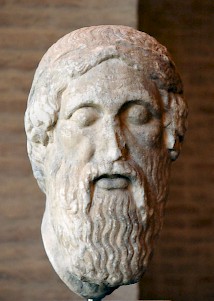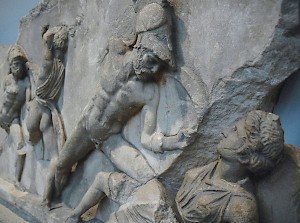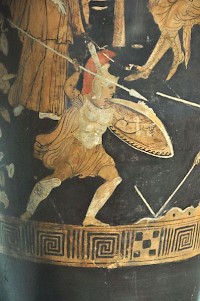Aethiopis
Epic Cycle (᾽Επικὸς κύκλος): set of twelve archaic epic poems, known to every educated Greek. The best-known were Homer's Iliad and Odyssey, which are also the only epics that have survived.
Summary

The Aethiopis is the seventh epic of the Epic Cycle; it is attributed to Arctinus of Miletus, and is a nice story about Achilles, the perfect warrior. He is purified after an error, and quickly overcomes Memnon, the son of Dawn: a demigod. On the moment of his victory and greatest glory, Achilles is killed. The episode of the quarrel between Ajax and Odysseus, which is now at the end of the story, appears to be an addition by an editor who wanted to create a bridge to the Little Iliad.
The Aethiopis begins where the Iliad breaks off. Penthesileia arrives, an Amazon queen, and the daughter of the war god Ares. She turns out to be a valiant fighter, but is nevertheless killed by Achilles. While the Trojans bury their ally, the Greeks meet and one of the common soldiers, Thersites, remarks that Achilles has been in love with the Amazon queen. That there was an element of truth in this accusation, is suggested by many representations, which show Achilles and Penthesileia looking into each other's eyes.

Nevertheless, it was not a clever thing to say: Achilles is really angry, and kills his critic. There is a dispute among the Greeks, because Thersites was a fellow-Greek and even though he was sharp-tongued, he ought to have been respected. Achilles is sent to the isle of Lesbos, where he has to sacrifice to Apollo, Artemis, and Leto, and is purified from bloodshed by Odysseus.
During his absence, a new Trojan ally arrives: Memnon, the son of Dawn. Like Achilles, he wears a panoply that has been made by Hephaestus. It does not help him: although he can kill the Greek warrior Antilochus, he is killed by Achilles. From representations of this scene on vases, we know that there must have been lines in the Aethiopis that describe how the fates of Achilles and Memnon were weighed by Zeus.
This turns out to be Achilles' last victory. Elated by his success, he pursues the Trojans, who flee back into their city. Achilles follows them, even passes the gate, but is shot by Paris. Ajax and Odysseus manage to recover the dead body. Thetis and the Muses arrive to mourn Achilles, and when the Greeks cremate her son, she takes his body away from the pyre and transfers it to the White Island. Still, a mound is erected, funeral games are organized, and Odysseus and Ajax start a quarrel about the panoply.
Proclus' excerpt

The Cypria, described in the preceding book, has its sequel in the Iliad of Homer, which is followed in turn by the five books of the Aethiopis, the work of Arctinus of Miletus. Their contents are as follows: The Amazon Penthesileia, the daughter of Ares and of Thracian race, comes to aid the Trojans, and after showing great prowess, is killed by Achilles and buried by the Trojans. Achilles then slays Thersites for abusing and reviling him for his supposed love for Penthesileia. As a result a dispute arises amongst the Achaeans over the killing of Thersites, and Achilles sails to Lesbos and after sacrificing to Apollo, Artemis, and Leto, is purified by Odysseus from bloodshed.
Then Memnon, the son of Eos, wearing armor made by Hephaestus, comes to help the Trojans, and Thetis tells her son about Memnon. A battle takes place in which Antilochus is slain by Memnon and Memnon by Achilles. Eos then obtains of Zeus and bestows upon her son immortality; but Achilles routs the Trojans, and, rushing into the city with them, is killed by Paris and Apollo. A great struggle for the body then follows, Ajax taking up the body and carrying it to the ships, while Odysseus drives off the Trojans behind. The Achaeans then bury Antilochus and lay out the body of Achilles, while Thetis, arriving with the Muses and her sisters, bewails her son, whom she afterwards catches away from the pyre and transports to the White Island. After this, the Achaeans pile him a cairn and hold games in his honor. Lastly a dispute arises between Odysseus and Ajax over the arms of Achilles.
Fragments
2. Scholiast on Homer, Iliad, 24.804:
Some read: “Thus they performed the burial of Hector. Then came the Amazon, the daughter of great-souled Ares, the slayer of men.”
3. Scholiast on Pindar, Isthmian Odes, 3.53:
The author of the Aethiopis says that Ajax killed himself about dawn.
Note
The translation of the excerpt in Proclus' Chrestomathy (transmitted to us by Photius) and the fragments was made by Hugh G. Evelyn-White, and was copied from LacusCurtius.